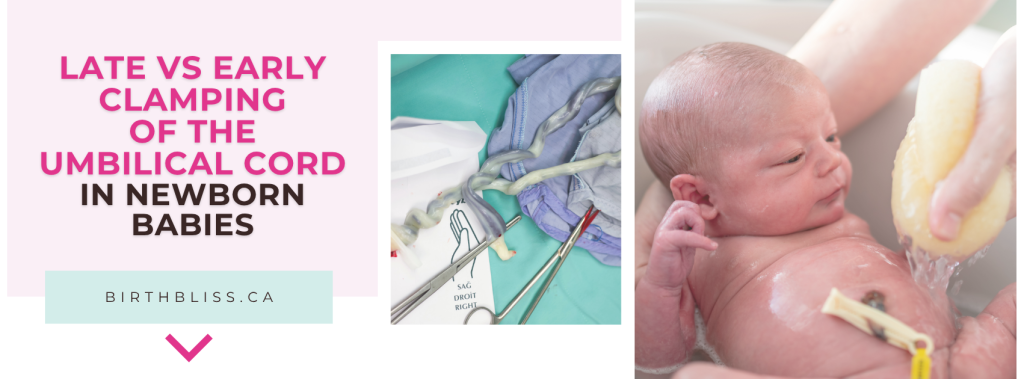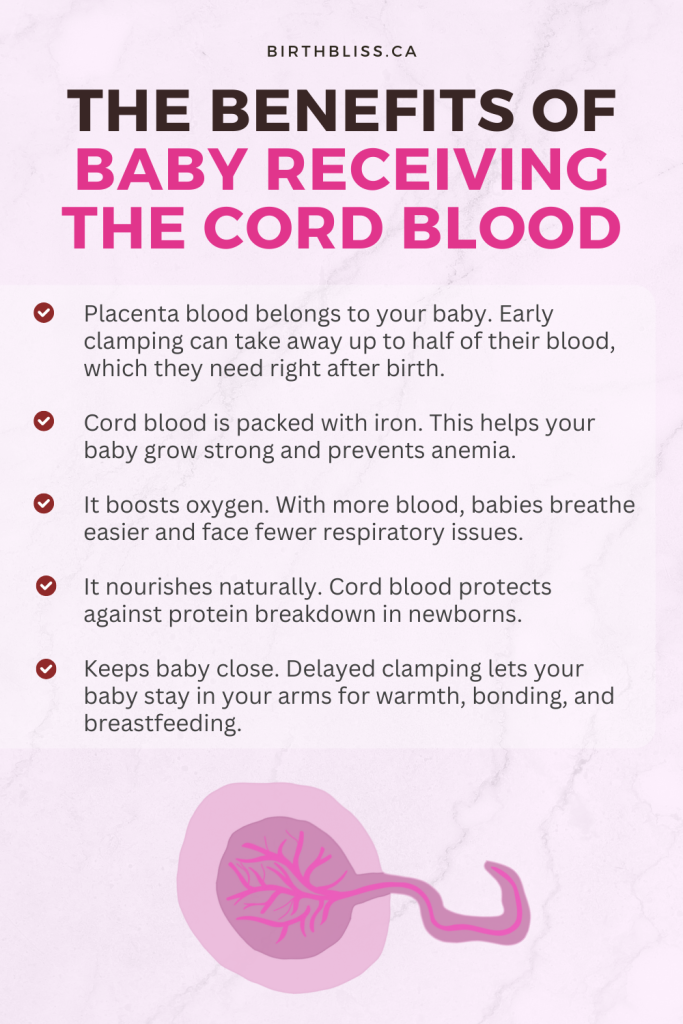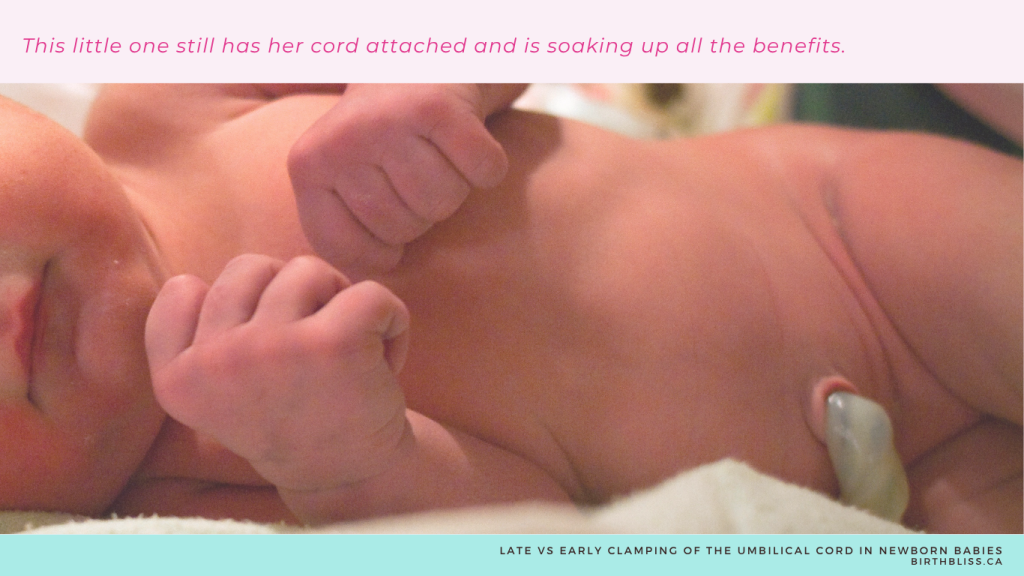
Lately, some of the women with whom I work have been advised by their doctor that their baby’s umbilical cord should be cut immediately after birth to prevent jaundice. While I respect these doctors, in this particular case, I do not believe that they are practicing evidence-based care.
What’s Evidence-Based Care?
Evidence-based practice means using quality scientific information to make a judgment. By identifying well-conducted research and applying it to practice, health care providers can improve the quality of care to mothers and babies, something that everyone involved wishes for!
The Benefits of Baby Receiving the Cord Blood
There is a large amount of scientific research showing the benefits of the baby receiving the cord blood:
- The blood in the placenta rightfully belongs to the baby, and babies not receiving this blood have to deal with the equivalent of a major blood loss or hemorrhage at birth. It is estimated that early clamping deprives the baby of 54 to 160 ml of blood, which represents up to half of a baby’s total blood volume at birth.
- There is a significant amount of iron in the cord blood, which the baby needs for optimal health and for the prevention of anemia.
- Babies benefit from the increased oxygen available to them from the cord blood when taking these first few breaths. The earlier the cord is clamped, the more likely the incidence of respiratory distress syndrome.
- The blood that babies receive through the cord after birth acts as a source of nourishment that protects infants against the breakdown of body protein.
- As a bonus, delayed cord clamping keeps babies in their mother’s arms, the ideal place to regulate their temperature and initiate bonding and breastfeeding.

Understanding Jaundice and Delayed Cord Clamping
The only concern with delayed cord clamping is a possible increase in hyperbilirubinemia, more commonly known as jaundice.
To fully understand this situation, one must recognize that there are two types of jaundice:
1. Physiological jaundice
Occurs naturally in a normal birth without interventions. It usually resolves itself without the need for treatment.
2. Non-physiological jaundice
Arises when medical interventions, medications crossing into the placenta, or premature birth occur. This type requires special consideration and neonatal care but is very treatable through sunlight exposure and phototherapy.
Late vs Early Clamping of the Umbilical Cord in Full-term Neonates

Below is a key research study summarizing the available data. It was published in 2007 in the Journal of the American Medical Association (JAMA).
Systematic Review and Meta-analysis of Controlled Trials
Eileen K. Hutton, PhD; Eman S. Hassan, MBBCh
JAMA. 2007;297:1241–1252.
Context
With few exceptions, the umbilical cord of every newborn is clamped and cut at birth, yet the optimal timing for this intervention remains controversial.
Objective
To compare the potential benefits and harms of late vs. early cord clamping in term infants.
Data Sources
Search of six electronic databases (as of November 15, 2006): the Cochrane Pregnancy and Childbirth Group trials register, the Cochrane Neonatal Group trials register, the Cochrane Library, MEDLINE, EMBASE, and CINHAL; plus hand-searching of secondary references and investigator contact.
Study Selection
Controlled trials comparing late vs. early cord clamping in infants born at ≥37 weeks’ gestation.
Data Extraction
Two reviewers independently assessed eligibility, quality, and extracted data for outcomes such as infant hematologic status, iron status, and risk of adverse events (jaundice, polycythemia, respiratory distress).
Data Synthesis
The meta-analysis included 15 controlled trials (1,912 newborns).
- Late clamping (≥2 minutes): n = 1,001 newborns
- Early clamping (immediate): n = 911 newborns
Findings
- Improved hematologic status: Weighted mean difference (WMD) 3.70% (95% CI, 2.00–5.40%)
- Improved ferritin and stored iron levels
- Clinically important reduction in anemia risk: RR 0.53 (95% CI, 0.40–0.70)
- Increased asymptomatic polycythemia (benign)
Conclusion
Delaying cord clamping for at least two minutes in full-term infants is beneficial to the newborn and extends into infancy. Although polycythemia risk increases slightly, it appears benign.
Author Affiliations
Department of Obstetrics and Gynecology, McMaster University, Hamilton, Ontario (Dr. Hutton); and The Child and Family Research Institute, University of British Columbia, Vancouver (Dr. Hassan)
Recommended Reading
If you wish to understand this issue on a deeper level, I recommend these two articles
1️⃣ Delayed Cord Clamping Should Be Standard Practice in Obstetrics
An excellent blog post by an OBGYN, great to print out and share with your doctor.
2️⃣ Leaving Well Alone: A Natural Approach to the Third Stage of Labour
By Dr. Sarah Buckley (2005) – first published in Lotus Birth and later expanded in Gentle Birth, Gentle Mothering.
“The medical approach to pregnancy and birth has become so ingrained in our culture that we have forgotten the ways of our ancestors…
At the time when Mother Nature prescribes awe and ecstasy, we have injections, examinations, and clamping and pulling on the cord.” — Dr. Sarah Buckley
References
- Ceriani Cernadas JM, et al. Pediatrics. 2006 Apr;117(4):e779–86.
- De Marsh, Q.B., et al. JAMA. (June 7, 1941).
- Saigat, Saroj, et al. Placental Transfusion and Hyperbilirubinemia in the Premature. 49:3 (March 1972).
- Rabe, H; Reynolds, G; Diaz-Rossello, J. Early versus delayed umbilical cord clamping in preterm infants (Cochrane Review). John Wiley & Sons; 2006.
- Usher R, et al. Acta Paediatr. 1963;52:497–512.
Additional Resources
- Expert calls for delayed clamping of umbilical cord in UK childbirths
- TEDx Talk: Alan Greene on Delayed Cord Clamping
You Might Also Like
Benefits of Vernix – It’s Amazing Stuff (and Here’s the Scientific Research to Prove It)
The white coating on your baby’s skin, vernix, has incredible antibacterial and moisturizing properties. That’s why babies shouldn’t be bathed right after birth.
Can What’s on the Shelves in Your Bathroom Hurt You?
Health Canada doesn’t require companies to prove product safety before selling, meaning we often learn something’s unsafe only after harm is shown.
✨Exclusive Deals:
- Grab Mellow Mornings for Pregnancy for a calm start to your day filled with baby love 💖 https://get.birthbliss.ca/mellow-mornings/
- Get relief from pregnancy nausea! 🤢 → 😌 Discover the Bye-Bye Morning Sickness Formula: https://get.birthbliss.ca/bye-byemorningsickness/
- Find Connection Inside BLOOMFUL. 🌸 Join a community of expecting moms just like you, exploring holistic tools for a better pregnancy. https://get.birthbliss.ca/bloomful/
- Grab the Guide to an Easier Birth 🌟: https://get.birthbliss.ca/bb/
- Join our FREE → ❤️ LOVE Your Birth Workshop: You’ll learn 3 steps to ease pain during labor (without an epidural): https://get.birthbliss.ca/training/





6 thoughts on “Late vs Early Clamping of the Umbilical Cord in Newborn Babies”
A great article Marie – thanks for sharing! A few days before I delivered, I too became curious about the literature on early cord clamping. I was amazed at the number of studies and theories suggesting that this practice leads to a variety of health problems and longterm health issues in children. For some conditions, like autism, the jury is still out and there isn’t enough evidence to know for sure – but I quickly realized how important of a decision this could be for my baby! (Up until that point I had included it on my birthing preferences letter under the advice of the Hypnobirthing program, but didn’t know much about the rationale behind it!)
The OBGYN-resident respected my wish to delay clamping until the cord stopped pulsating (or she said it had anyway)- which was only about 1-2 minutes after my baby was delivered. Because my husband and I had chosen to do cordblood banking, I was concerned that there wouldn’t be enough blood to fill the vials. (However, I reasoned that it was more important for my baby to get these vital stemcells at the time of his birth, something that likely will benefit him now and throughout his life). It turned out that there was enough blood for the cordbanking, even after delaying clamping. I was happy about this, but the Buckley article seems to suggest that if you delay clamping then there won’t be enough cordblood to bank? I did read an article by a labour and delivery nurse who said that she always finds there is enough blood for banking after delayed clamping – she said that sometimes you just need to “milk the placenta” after it is delivered.
Hi Brandy,
Thanks for the info. I haven’t had anyone here do both the cord banking and the delayed cord clamping, but the information that I had from other hypnobirthing practitioners, is that it is possible to do both. I’m glad to hear that someone close to home did both as well. I would agree with your delivery nurse. 🙂
Thanks Marie for the info on this important topic, and for including my article. My new book has an update of this with alot more information about the pros and cons of cord blood banking.
Below is my take on delayed clamping and cord blood banking, from my book,
I would urge families to read the whole chapter before deciding on this issue, which medical research (and most profesoional bodies) shows is very very very unlikely to be useful to the baby or family.
More about my book here
http://www.sarahjbuckley.com/html/new-gentle-birth-gentle-mothering.htm
Blessings, Sarah
Although cord blood harvesting is promoted by both public and private
institutions as harmless to the baby, it involves collecting the newborn’s
placental transfusion and requires early clamping—ideally within thirty
seconds of birth—so that an adequate number of stem cells is obtained.
Delayed cord clamping, which allows this blood to transfer to the baby,
as discussed earlier, is likely to lead to an inadequate volume of blood
harvested.
For example, in one study the volume of cord blood obtained was
reduced from 75 milliliters, collected when the cord was clamped at 30
seconds after birth, to 39 milliliters collected when clamping occurred
between 30 and 180 seconds. A low-volume collection indicates insufficient
stem cells to be usable for transfusion.(ref 103) Public cord blood banks generally discard collections below 40 milliliters [because of an inadequate number of stem cells for later use],(ref 104) with overall one-third to onehalf
of collections discarded, mostly because of low volume.96, (ref 105) Private
banks, which are paid by parents to collect and store their baby’s blood, do
not generally discard the collections, and some may have a policy to accept
lower volumes, although this may not guarantee usefulness.
Some centers collect residual blood from the placenta after it is delivered,
although the amount is usually less than that obtained from the
cord straight after birth, and still requires early cord clamping for an
adequate collection.(ref 103) Contamination is also more likely with a placental
collection.
: